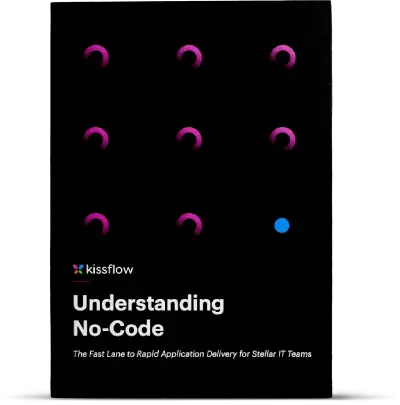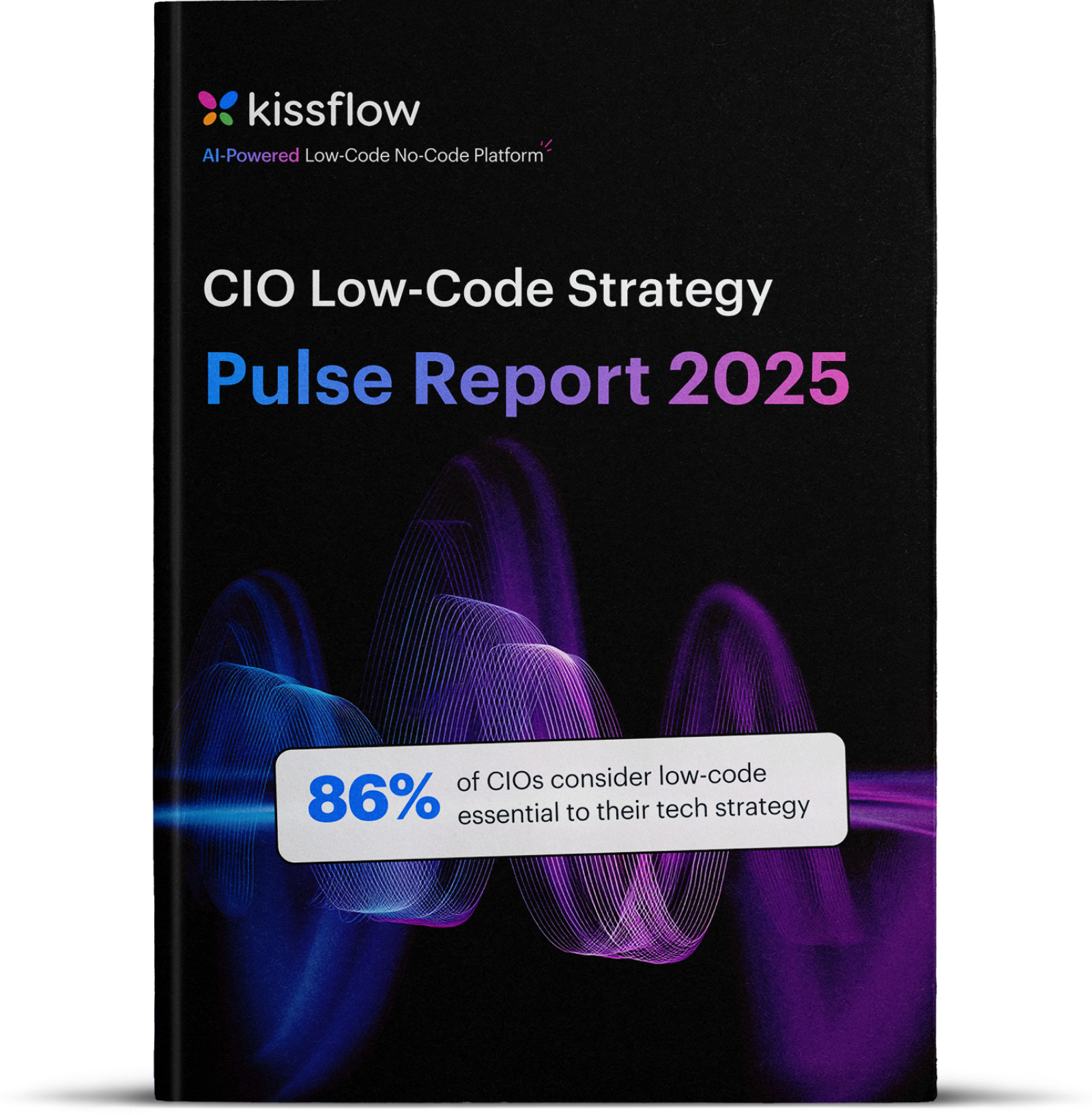
- >
- No-code Platform>
- Enterprise Innovation at Scale: How No-Code Is Reshaping Digital Transformation in 2025
Enterprise Innovation at Scale: How No-Code Is Reshaping Digital Transformation in 2026
Digital transformation has become table stakes. Every enterprise claims to be transforming digitally. Yet most struggle to move beyond pilot projects and proof-of-concepts. The gap between digital aspiration and digital reality is wide. What separates enterprises that actually achieve transformation at scale from those stuck in perpetual planning? Increasingly, the answer is no-code platforms that make innovation accessible across the organization, not just within IT.
The global no-code development market was worth $14.9 billion in 2022 and is expected to reach $102.7 billion by 2031, growing at 24.1% annually. This isn't technology hype. It's enterprises voting with their budgets that no-code is fundamental to digital transformation at scale.
How no-code enables enterprise innovation at unprecedented scale
Traditional innovation in enterprises faced structural constraints. Good ideas emerged throughout the organization, but only a small fraction could be resourced for development. Innovation is bottlenecked at IT. No-code fundamentally changes this equation by making innovation accessible at the edge of the organization.
Democratizing innovation beyond IT
The most important shift no-code enables is psychological, not technical. When business users can build solutions themselves, they start thinking differently about problems. Instead of documenting requirements and hoping IT prioritizes them, they prototype solutions directly. Instead of accepting the limitations of existing tools, they build what they actually need.
This mindset shift unleashes innovation that was always present but couldn't previously manifest into working solutions. By 2026, 70% of new business apps will be built using no-code tech. Most of these applications will be built by business users, not professional developers.
Compressing innovation cycles
Traditional software development measured innovation in quarters or years. No-code compresses this to weeks or days. An idea tested this morning can be in users' hands this afternoon. This acceleration fundamentally changes what's possible because failure becomes cheap. You can test ten ideas in the time it previously took to build one. Most will fail, but the few that succeed drive real value. This rapid experimentation approach to innovation only works when the cost and time to test ideas is minimal.
App development is 90% faster with low-code platforms. This speed advantage changes not just how fast you innovate but how you think about innovation.
Enabling continuous evolution
Digital transformation isn't a destination you reach. It's a continuous adaptation to changing business conditions, customer expectations, and competitive dynamics. No-code supports this ongoing evolution by making change straightforward rather than expensive and risky.
Applications built on no-code platforms can be modified as requirements evolve. Workflows adapt to new processes. Interfaces adjust to changing user needs. This flexibility means digital transformation isn't a multi-year project followed by years of stagnation. It's continuous improvement becoming the normal operating mode.
Digital transformation through no-code: What's actually working
The phrase digital transformation has become almost meaningless through overuse. Looking at specific patterns of successful transformation helps distinguish real change from rebranded IT projects.
Automating the middle
Most enterprises have successfully automated highly repetitive, high-volume transactions. They've also retained human judgment for complex, high-stakes decisions. The massive opportunity is the middle: processes that involve some judgment but follow general patterns, require coordination across systems, combine data from multiple sources, and happen frequently enough to matter but not so frequently that traditional automation was economical.
No-code platforms excel at automating this middle. Business users who understand these processes can build automation directly. The result is thousands of small process improvements that collectively transform operations.
69% of daily managerial operations will be entirely automated by 2024. Much of this automation targets exactly this middle layer, where pure transaction automation doesn't fit, but pure human judgment isn't required.
Creating adaptive customer experiences
Customer expectations evolve constantly. What delighted customers last year is expected this year and insufficient next year. Traditional development cycles can't keep pace. By the time you build what customers want, they want something different.
No-code lets customer-facing teams directly improve experiences. Customer service representatives who know what frustrates customers can build better self-service flows. Sales teams who understand buyer journeys can create better qualification processes. Marketing teams who see what content resonates can personalize experiences.
This direct connection between customer insights and implementation dramatically accelerates experience innovation.
Bridging enterprise systems
Enterprise application portfolios accumulated over decades rarely integrate well. Data silos prevent holistic views. Workflows span multiple systems with manual handoffs. Users toggle between applications to complete tasks. Traditional integration projects are expensive and fragile.
No-code platforms provide an integration layer that connects systems without complex custom coding. Business users can build unified interfaces that pull data from multiple sources. Workflows can span systems automatically. This doesn't replace proper API-based integration, but it solves many integration problems faster and more flexibly.
Modernizing gradually, not dramatically
The most successful digital transformations don't rip out and replace entire systems. They gradually introduce new capabilities alongside existing systems, prove value in production, migrate additional functionality incrementally, and eventually phase out legacy systems that have been fully replaced.
No-code enables this gradual approach by making it economical to build new interfaces and workflows that integrate with legacy systems. You get modern user experiences and automation without the risk of big-bang replacements.
The legacy application modernization market is valued at approximately $24.8 billion in 2024 and is anticipated to reach around $64.4 billion by 2033, reflecting a CAGR of 11.2%. Much of this modernization is happening through incremental no-code approaches.
Enterprise-wide digital transformation: The organizational challenge
Technology enables transformation, but organizational factors determine success or failure. The hardest aspects of digital transformation aren't technical.
Building the transformation coalition
Successful transformation requires champions across the organization, not just IT leadership. You need business unit leaders who actively sponsor no-code initiatives, process owners who see automation as empowering rather than threatening, IT leaders who embrace enablement over gatekeeping, and executive sponsorship that removes organizational barriers.
Building this coalition requires demonstrating value quickly and repeatedly. Each successful no-code project creates momentum for the next.
Managing the cultural transition
No-code challenges traditional roles and relationships. IT is no longer the sole builder of technology solutions. Business units gain capabilities they didn't have before. This shift threatens some people and energizes others. Acknowledge concerns rather than dismissing them. Provide training to help people adapt to new roles. Celebrate early adopters who embrace the change. Be patient with resistance while maintaining momentum.
80% of Non-IT Pros will create IT solutions by 2024, with over 65% turning to no-code tools. This democratization of technology development requires cultural change, not just process change.
Measuring transformation progress
Digital transformation needs metrics that reflect real business change, not just technology deployment. Track business process efficiency gains, customer experience improvements, employee productivity increases, innovation velocity (ideas to production), and cost reductions from automation.
These business-focused metrics demonstrate value to executives and help maintain organizational commitment when transformation becomes difficult.
Sustaining momentum through inevitable challenges
Every transformation hits obstacles. Early enthusiasm wanes. Challenging integrations slow progress. Politics emerge around who controls what. Sustaining momentum requires anticipating challenges proactively, celebrating wins to maintain enthusiasm, learning from failures without abandoning the approach, and continuously demonstrating value through successful deployments.
The enterprises that succeed at digital transformation treat it as a journey requiring sustained commitment rather than a project with a defined end date.
The competitive imperative of no-code transformation
Digital transformation through no-code isn't just about internal efficiency. It's increasingly a competitive requirement.
Speed as a competitive advantage
Markets move faster than ever. Customer expectations evolve constantly. Competitive threats emerge overnight. The ability to adapt quickly becomes decisive. Organizations that can test and deploy new capabilities in weeks compete differently from those requiring months or quarters. This speed advantage compounds. Over the years, faster organizations experiment more, learn more, and evolve more successfully.
Organizations can respond to market changes, regulatory requirements, or operational needs in weeks instead of months with low-code platforms. This responsiveness is becoming a core competitive capability.
Innovation capacity
Every enterprise faces the same constraint: limited innovation capacity relative to innovation opportunities. Traditional approaches maximize this capacity through careful prioritization. No-code multiplies capacity by distributing innovation across the organization. More people can innovate. More ideas can be tested. More value can be captured.
Your competitors are discovering this. The question is whether you discover it first or play catch-up.
Talent attraction and retention
Top talent wants to work with modern tools and approaches. Organizations stuck in traditional development modes struggle to attract and retain the best people. Offering no-code capabilities signals that your organization embraces innovation and empowers employees to drive change. This matters for recruiting and retention.
The global shortage of full-time software developers is expected to reach 4 million by 2026. No-code helps address this shortage while also making your organization more attractive to the talent you do have.
How Kissflow powers enterprise digital transformation
No-code companies driving digital transformation are at the forefront of the next industrial revolution, providing solutions that empower businesses to innovate rapidly.
Kissflow provides the foundation for digital transformation at scale. The low-code platform enables rapid application development and workflow automation across the enterprise. Pre-built integrations connect with existing systems, enabling gradual modernization without ripping and replacing. The unified platform means applications and workflows built by different teams integrate naturally.
Business users get the tools to innovate directly in their areas of expertise. IT gets governance capabilities to maintain appropriate controls. Executives get visibility into transformation progress through comprehensive analytics.
This combination of capability, governance, and visibility is what makes transformation at scale possible rather than just aspirational.
FAQs:
1: What roles belong in a No-Code CoE team?
A comprehensive CoE includes: (1) CoE Lead/Director - sets strategy, secures executive support, manages budget and priorities (1 FTE), (2) Platform Architects - design technical standards, data models, integration patterns (2-3 FTE), (3) Governance Manager - defines policies, manages compliance, oversees security reviews (1 FTE), (4) Training & Enablement Lead - develops curriculum, certifies citizen developers, manages communities (1-2 FTE), (5) Solution Architects - consult on complex projects, provide technical guidance (2-4 FTE), (6) Business Process Analysts - help departments map and optimize workflows (2-3 FTE), (7) Integration Specialists - build complex API connections and data transformations (2-3 FTE), and (8) Community Managers - facilitate knowledge sharing, manage template libraries (1 FTE). Team size scales with organization: start with 3-5 core members for 1000-5000 employees, grow to 15-20 for 10,000+ employees.
2: How do we define governance policies for citizen developers?
Effective governance policies cover: (1) Authorization - who can build apps (based on training/certification), what types of apps require approvals, (2) Data access - classification levels (public, internal, confidential, restricted) with corresponding access requirements, (3) Security standards - mandatory requirements for authentication, encryption, audit logging based on data sensitivity, (4) Development process - requirements for testing, documentation, user acceptance before production, (5) Change management - how updates are deployed, rollback procedures, maintenance windows, (6) Integration rules - approved external connections, API usage policies, data exchange standards, (7) Lifecycle management - archival policies for unused apps, sunsetting procedures, (8) Support model - who provides ongoing support (builder, CoE, IT), and (9) Compliance requirements - industry-specific regulations (HIPAA, SOX, GDPR) and how to meet them. Policies should be progressive - stricter requirements for higher-risk applications.
3: How do we onboard, train, and certify employees?
Comprehensive enablement includes: (1) Foundational training - 2-3 day bootcamp covering platform basics, visual development, workflow logic (required for all citizen developers), (2) Role-based curriculum - specialized tracks for power users, analysts, business owners with hands-on labs, (3) Certification program - multi-level credentials (Foundation, Professional, Expert) validating skills through practical exams, (4) Ongoing learning - monthly workshops on advanced features, new releases, best practices, (5) Mentorship - pairing new developers with experienced builders for real projects, (6) Documentation and resources - comprehensive knowledge base, video tutorials, template galleries, (7) Office hours - regular CoE availability for questions and guidance, (8) Sandbox environments - practice areas where users can experiment without risk, and (9) Assessment and feedback - tracking completion, gathering input, continuously improving content. Target: certify 5-10% of workforce in first year, 15-25% by year three.
4: What frameworks prevent duplication and low-quality apps?
Quality frameworks include: (1) Intake process - standardized request form capturing business case, requirements, avoiding duplicate efforts, (2) Portfolio review - quarterly assessment identifying overlapping applications for potential consolidation, (3) Design reviews - CoE validating architecture for complex or sensitive applications before development, (4) Quality gates - automated checks for security, performance, accessibility, code quality before production, (5) Template enforcement - requiring use of pre-approved patterns for common scenarios, (6) Peer review - having experienced builders critique applications, (7) User acceptance testing - requiring business stakeholder sign-off before deployment, (8) Performance monitoring - tracking application metrics with alerts for issues, (9) Regular audits - periodic review of application portfolio for compliance and quality, and (10) Sunsetting unused apps - decommissioning applications with <10 users or <5% utilization after 6 months.
5: How does a CoE partner with IT and business stakeholders?
Successful partnerships involve: (1) Joint governance - CoE, IT, and business leaders co-owning policies and priorities, (2) Clear escalation paths - defining when CoE hands off to IT for complex requirements, (3) Shared services model - IT providing infrastructure, security, integrations; CoE enabling building; business defining requirements, (4) Regular sync meetings - weekly CoE-IT alignment, monthly stakeholder forums discussing roadmap and challenges, (5) Service level agreements - defining CoE response times for support requests, review timelines, (6) Funding model - business units contributing to CoE budget based on value received, (7) Project prioritization - transparent criteria considering business impact, technical feasibility, strategic alignment, (8) Success metrics - jointly defining and tracking KPIs that matter to all parties, and (9) Conflict resolution - established process for addressing disagreements about governance, priorities, or resources. CoE acts as bridge between IT's governance needs and business's agility requirements, balancing both effectively.
Accelerate your digital transformation with no-code platform

Ultimate Buyer's Guide to No Code
Thank you for downloading the ebook!
Related Articles










